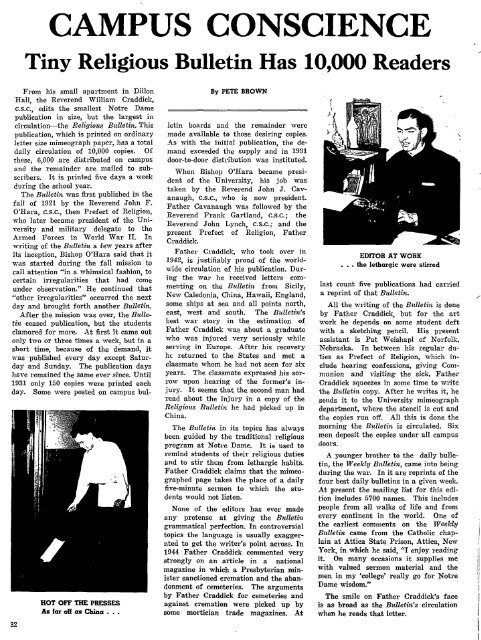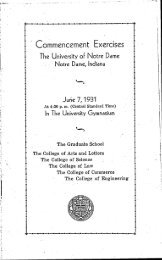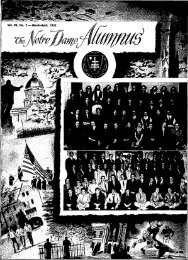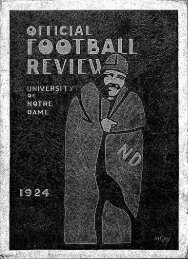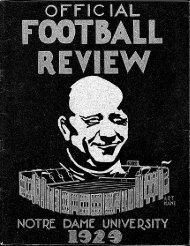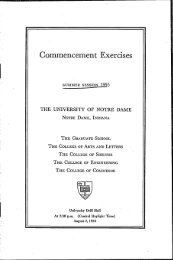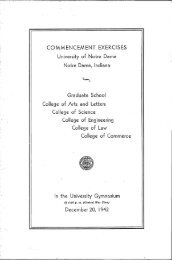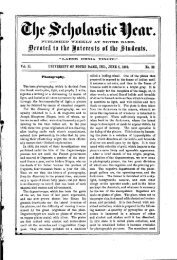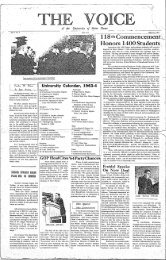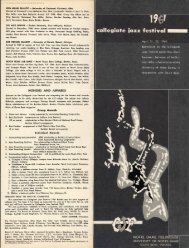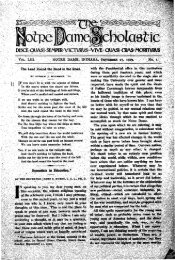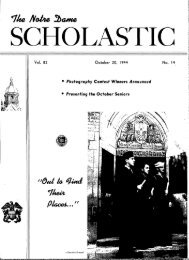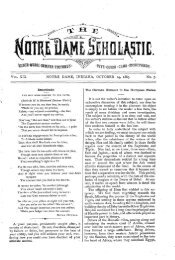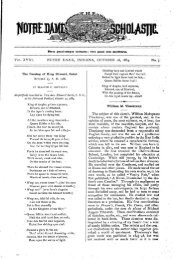Notre Dame Scholastic, Vol. 89, No. 26 - Archives - University of ...
Notre Dame Scholastic, Vol. 89, No. 26 - Archives - University of ...
Notre Dame Scholastic, Vol. 89, No. 26 - Archives - University of ...
Create successful ePaper yourself
Turn your PDF publications into a flip-book with our unique Google optimized e-Paper software.
CAMPUS CONSCIENCE<br />
Tiny Religious Bulletin Has 10,000 Readers<br />
From his small apartment in Dillon<br />
Hall, the Reverend William Ci-addick,<br />
c.s.c, edits the smallest <strong><strong>No</strong>tre</strong> <strong>Dame</strong><br />
publication in size, but the largest in<br />
circulation—^the Religious Bulletin. This<br />
publication, which is printed on ordinary<br />
letter size mimeograph paper, has a total<br />
daily circulation <strong>of</strong> 10,000 copies. Of<br />
these, 6,000 are distributed on campus<br />
and the remainder are mailed to subscribers.<br />
It is printed five days a week<br />
during the school year.<br />
The Bidletin was first published in the<br />
fall <strong>of</strong> 1921 by the Reverend John F.<br />
O'Hara, C.S.C., then Prefect <strong>of</strong> Religion,<br />
who later became president <strong>of</strong> the <strong>University</strong><br />
and military delegate to the<br />
Armed Forces in World War II. In<br />
writing <strong>of</strong> the Bulletin a few years after<br />
its inception, Bishop O'Hara said that it<br />
was started during the fall mission to<br />
call attention "in a whimsical fashion, to<br />
certain irregularities that had come<br />
under observation." He continued that<br />
"other irregularities" occurred the next<br />
day and brought forth another Bulletin.<br />
After the mission was over, the Bulletin<br />
ceased publication, but the students<br />
clamored for more. At first it came out<br />
only two or three times a week, but in a<br />
short time, because <strong>of</strong> the demand, it<br />
was published every day except Saturday<br />
and Sunday. The publication days<br />
have remained the same ever since. Until<br />
1931 only 150 copies were printed each<br />
day. Some were posted on campus bul-<br />
32<br />
HOT OFF THE PRESSES<br />
As for <strong>of</strong>f as China . . .<br />
By PETE BROWN<br />
letin boards and the remainder were<br />
made available to those desiring copies.<br />
As with the initial publication, the demand<br />
exceeded the supply and in 1931<br />
door-to-door distribution was instituted.<br />
When Bishop O'Hara became president<br />
<strong>of</strong> the <strong>University</strong>, his job was<br />
taken by the Reverend John J. Cavanaugh,<br />
c.s.c, who is now president.<br />
Father Cavanaugh was followed by the<br />
Reverend Frank Gartland, C.s.c; the<br />
Reverend John Lynch, C.S.C; and the<br />
present Prefect <strong>of</strong> Religion, Father<br />
Craddick.<br />
Father Craddick, who took over in<br />
1942, is justifiably proud <strong>of</strong> the worldwide<br />
circulation <strong>of</strong> his publication. During<br />
the war he I'eceived letters commenting<br />
on the Bulletin from Sicily,<br />
New Caledonia, China, Hawaii, England,<br />
some ships at sea and all points north,<br />
east, west and south. The Bulletin's<br />
best war story in the estimation <strong>of</strong><br />
Father Craddick was about a graduate<br />
who was injured very seriously while<br />
serving in Europe. After his recovery<br />
he returned to the States and met a<br />
classmate Avhom he had not seen for six<br />
years. The classmate expressed his sorrow<br />
upon hearing <strong>of</strong> the former's injury.<br />
It seems that the second man had<br />
read about the injury in a copy <strong>of</strong> the<br />
Religious Bulletin he had picked up in<br />
China.<br />
The Bulletin in its topics has always<br />
been guided by the traditional religious<br />
program at <strong><strong>No</strong>tre</strong> <strong>Dame</strong>. It is used to<br />
remind students <strong>of</strong> their religious duties<br />
and to stir them from lethargic habits.<br />
Father Craddick claims that the mimeographed<br />
page takes the place <strong>of</strong> a daily<br />
five-minute sermon to which the students<br />
would not listen.<br />
<strong>No</strong>ne <strong>of</strong> the editors has ever made<br />
any pretense at giving the Bulletin<br />
grammatical perfection. In controversial<br />
topics the language is usually exaggerated<br />
to get the writer's point across. In<br />
1944 Father Craddick commented very<br />
strongly on an article in a national<br />
magazine in which a Presbyterian minister<br />
sanctioned cremation and the abandonment<br />
<strong>of</strong> cemeteries. The arguments<br />
by Father Craddick for cemeteries and<br />
against cremation were picked up by<br />
some moi-tician trade magazines. At<br />
EDITOR AT WORK<br />
. . . the lethargic were stirred<br />
last count five publications had carried<br />
a reprint <strong>of</strong> that Bulletin.<br />
All the v/riting <strong>of</strong> the Bulletin is done<br />
by Father Craddick, but for the art<br />
work he depends on some student deft<br />
with a sketching pencil. His present<br />
assistant is Pat Weishapl <strong>of</strong> <strong>No</strong>rfolk,<br />
Nebraska. In between his regular duties<br />
as Prefect <strong>of</strong> Religion, which include<br />
hearing confessions, giving Com.munion<br />
and visiting the sick. Father<br />
Craddick squeezes in some time to Avrite<br />
the Bulletin copy. After he writes it, he<br />
sends it to the <strong>University</strong> mimeograph<br />
department, where the stencil is cut and<br />
the copies run <strong>of</strong>lf. All this is done the<br />
morning the Btdletin is circulated. Six<br />
m.en deposit the copies under all campus<br />
doors.<br />
A younger brother to the daily bulletin,<br />
the Weekly Bulletin, came into being<br />
during the war. In it are reprints <strong>of</strong> the<br />
four best daily bulletins in a given week.<br />
At present the mailing list for this edition<br />
includes 5700 names. This includes<br />
people from all walks <strong>of</strong> life and from<br />
every continent in the world. One <strong>of</strong><br />
the earliest comments on the Weekly<br />
Bulletin came from the Catholic chaplain<br />
at Attica State Prison, Attica, New<br />
York, in which he said, "I enjoy reading<br />
it. On many occasions it supplies me<br />
with valued sermon material and the<br />
men in my 'college' really go for <strong><strong>No</strong>tre</strong><br />
<strong>Dame</strong> wisdom."<br />
The smile on Father Craddick's face<br />
is as broad as the Bulletin's circulation<br />
when he reads that letter.


